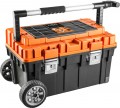Size
The main size of the container for tools. Inches are traditionally used for this designation, and the length is usually indicated as the main size. This information allows you to evaluate the "weight category" of the product as a whole, as well as to determine whether it is suitable for a particular instrument of large sizes. At the same time, the characteristics usually indicate the overall dimensions on all three main sides (in millimetres), however, it is more convenient for many craftsmen to use the size designation in inches.
For kits (see below), this paragraph indicates the dimensions of all containers supplied in the kit.
Organizer slots
The number of individual cells provided in the organizer. In this case, we can talk about an organizer as a separate device (see "Type"), or a set of cells built into the lid of the box (see "Lid with an organizer"). And for solutions with removable partitions, in which cells can be combined, the maximum number is indicated — with all installed partitions.
Organizers, by definition, are designed mainly for small things. Therefore, the more cells there are, the more varieties of small items can be stored in a container. For example, in 10 cells you can keep bolts of five different sizes and separately nuts for them. Such a number of compartments —
up to 10 — is generally considered small, but in fact it is often quite enough.
11 – 20 cells can be called an average, and the most capacious organizers have
up to 30 compartments. However it is worth considering that with the same dimensions of the container, an increase in the number of cells leads to a decrease in their volume.
Adjustable compartment size
Possibility
to change the size of the compartments provided in the tool box. This function is mainly used in
organizers(see "Type"). Usually, the partitions in such products (all, or at least most) can be removed and rearranged, thus adjusting the size, number and even shape of the compartments — for example, to provide enough space for a relatively large tool like a screwdriver or pliers. Another option is
bags and
backpacks(see ibid.), in which individual compartments can grow and shrink through the use of zippers or zip ties. Here the meaning of this function is somewhat different: it is aimed at optimizing the use of internal space depending on the amount of content. For example, if there is little content, a bag or backpack can be “squeezed” so that things do not hang around the cabin; and when an additional load appears, loosen the ties or unzip, providing the necessary volume.

